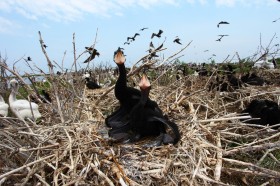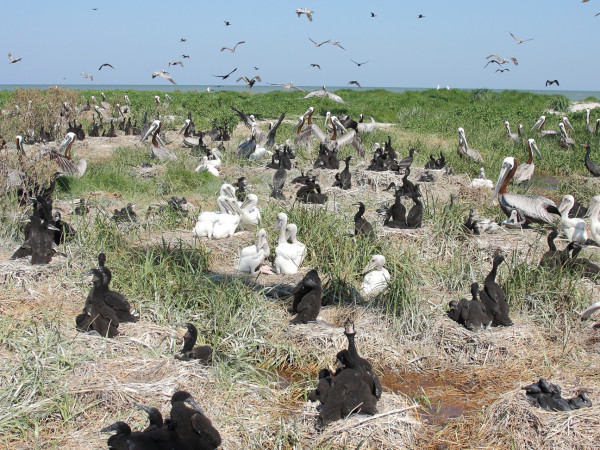Chesapeake Bay cormorants continue steep ascent
KE Still on Pamunkey River Nov 21
November 23, 2013Camellia at Stumpy Lake Dec 4 2013
December 7, 2013

Cormorant chicks on nest within the Chesapeake Bay. Photo by Bryan Watts.
On 23 May, 1978, while out conducting fieldwork, Charlie Blem (avian ecologist from Virginia Commonwealth University) discovered 6 pairs of double-crested cormorants nesting on the James River near Hopewell, Virginia. This was the first documented breeding of the species within the Chesapeake Bay region. The historic event was little noticed and there was no indication that in just over 3 decades the species would take root and become one of the dominant fish consumers within the estuary. However, during the 2013 breeding season, a survey conducted by The Center for Conservation Biology documented more than 5,000 pairs breeding in 12 colonies throughout the Chesapeake Bay. This population would be expected to consume nearly 3000 metric tons of fish annually.
Growth in the Chesapeake Bay breeding population has been both rapid and dramatic. As recently as 1993, a survey conducted by the Center documented only 354 pairs. During a visit in that year to Smith Island, Bryan Watts and Mitchell Byrd discovered 6 nests built on top of old brown pelican nests. In 2013, this colony is the largest in the Bay supporting nearly 2,500 pairs.

Mixed double-crested cormorant and brown pelican colony on Smith Island in the Chesapeake Bay. Photo by Bart Paxton.
Cormorants of several species are now considered nuisances within numerous locations across the globe. In North America, populations were recovering from widespread shooting during the 1940s and 1950s only to be reduced to new lows by the 1960s due to the impacts of DDT. Since the banning of DDT, historic populations have experienced dramatic recoveries leading to conflicts over the destruction of habitat required by other bird species, nutrient inputs into waterways, and fish consumption. Impacts of overwintering populations on the aquaculture industry throughout the Southeast led the Fish and Wildlife Service to issue an aquaculture depredation order for 13 southern states in 1998. Conflicts with commercial and recreational fishing have led to the ongoing control of northern breeding populations.

Forested island in the upper James River that support cormorant roosts during the winter. Heavy guano may kill trees over time forcing the roosts to relocate. Photo by Bryan Watts.
The Chesapeake Bay has always been a significant wintering site for northern populations. For the decade prior to the discovery of breeding there was a documented increase of cormorants using the Bay during winter. The current size of the winter population is not known but believed to be substantial. Northern birds that have not reached breeding age also oversummer in the Bay in unknown numbers. The rise of the breeding population greatly increases the fish demand during the summer period.
Written by
Bryan Watts | bdwatt@wm.edu | (757) 221-2247
December 3, 2013



